Abstract
Drones have been increasingly used in firefighting to improve the response speed and reduce the dangers to human firefighters. However, few studies simultaneously consider fire spread prediction, drone scheduling, and the configuration of supporting staff and supplies. This paper presents a mathematical model that estimates wildfire spread and economic losses simultaneously. The model can also help us to determine the minimum number of firefighting drones in preparation for wildfire in a given wild area. Next, given a limited number of firefighting drones, we propose a method for scheduling the drones in response to wildfire occurrence to minimize the expected loss using metaheuristic optimization. We demonstrate the performance advantages of water wave optimization over a set of other metaheuristic optimization algorithms on 72 test instances simulated on selected suburb areas of Hangzhou, China. Based on the optimization results, we can pre-define a comprehensive plan of scheduling firefighting drone and configuring support staff in response to a set of scenarios of wildfire occurrences, significantly improving the emergency response efficiency and reducing the potential losses.
1. Introduction
Wildfires, such as forest fires and mountain fires, are one of the most frequent disasters causing great economic losses, environmental damage, and threats to lives worldwide. Efficient firefighting operations are critical to reduce the losses. However, traditional firefighting operations often pose significant dangers to human firefighters. In addition, traditional aerial firefighting using helicopters, air tankers, and other manned aircraft are often limited in low flexibility, scalability, and cost-effectiveness [1,2]. In recent years, unmanned robotics, especially drones (also known as unmanned aerial vehicles, UAVs), have been increasingly used in firefighting operations to improve the response speed and economic effectiveness while reducing the dangers to human firefighters [3,4,5,6]. In wild areas, the typical usage of firefighting drones is to deliver water capsules (bags) to fire spots and then release water (or other water-based liquids) in dispersed form to suppress fire in the covered area [7,8]. Depending on the types of drones, the amount of water that a drone carries at a time typically varies from 10 to 1000 kg. Figure 1 shows a TD220 coaxial firefighting drone (made by Zhongzhihang [9]), which has a payload of 120 kg.
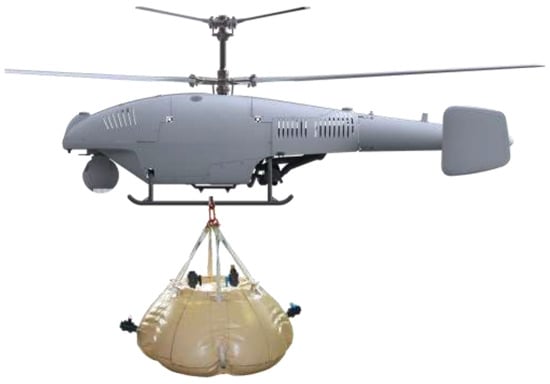
Figure 1.
A firefighting drone with a water capsule [9].
Qin et al. [3] designed a drone firefighting system, which consisted of a quadcopter as the platform, a transmission system to collect and release water, a kinematic-based navigation system, and a mission control system to coordinate the drone to find an optimal path (with respect to distance and power consumption) to the fire spot and then suppress the fire. Viegas et al. [10] designed a lightweight tethered UAV forest firefighting drone, which utilized water jet propulsion combined with multi-rotor propulsion to increase the flight endurance. However, receiving a continuous intake of water for firefighting can be impossible in wild areas, as the operational distance is limited by the length of the aerial hose. Using water capsules delivered by aircraft, to and released on the fire spot, eliminates this limitation [11]. The aircraft releases a water capsule at an appropriate position. When moving in a medium above the critical temperature, the capsule shell accumulates an integral amount of damage; when the damage reaches the value of the thermal stability coefficient of the shell, the shell breaks and releases water in dispersed form [8]. Explosive blasts in water makes shock waves, so shock waves propagate in water first and then beyond water to continue propagation in the air. Explosive water mist lowers the temperature, insulates oxygen, and asphyxiates the absorption of heat radiations. Large momentum also enables the mist to pass through smoke to act on the surface of fuel and (sometimes) soaks into the fuel further [12]. Successive explosions of multiple capsules can distribute water to cover the fire vulnerability zone more fully. How to choose an appropriate water-dropping scheme to achieve the optimal firefighting effect is quite a difficult problem. Śmigielski et al. [13] used a numerical method of distribution propagation and uncertainty propagation to analyze the precision of system controlling delivery of a water capsule by a helicopter. Czerniak et al. [14] employed an artificial bee colony (ABC) to optimize the physical model of flight of a water bag dropped from an aircraft. They also used the ABC method to optimize fuel consumption of the aircraft [15]. Wang et al. [16] proposed a combined genetic algorithm (GA) for optimizing the water-dropping scheme for a fixed-wing firefighting aircraft based on a neural network agent model between the aircraft water-dropping schema and a water distribution polygon.
Smart drones are subject to limited endurance and low load capabilities. Effective path planning (if needed, with the consideration of obstacle and collision avoidance) of firefighting drones in a complex, wild environment is important. UAV path planning methods have been extensively studied in the literature, which can be categorized into local and global search methods depending on whether path planning is considered as a global optimization problem [17]. Global search methods can be further divided into problem-specific heuristic methods and metaheuristic methods [18,19,20,21]. Luo et al. [22] proposed an improved D*Lite algorithm for planning the paths of UAVs supplemented by unmanned ground vehicles (UGVs), which is effective even when the 3D workspace is only partially known. Harikumar et al. [23] proposed an Oxyrrhis-Marina-inspired search and dynamic formation control method, which first selects between Levy flight, Brownian search, and directionally driven Brownian search for target identification and then controls the UAVs to fly in a dynamic formation to quench the fire using water. Zheng et al. also studied the heuristic and metaheuristic methods to search and identify targets using UAVs [24] as well as human–UAV cooperation [25,26]. Wang et al. [27] proposed an adaptive vortex search algorithm of planning optimal firefighting UAV paths in terms of the solution quality, length, and energy. Xiang and Wang [28] presented an improved ant colony optimization (ACO) algorithm, which combines pseudo-random rules and roulette, and updates the pheromone concentration based on the distribution rules of the wolf colony algorithm to give strong feedback to the ants. Based on a forest fire risk map, Xu et al. [29] presented a method using ring self-organizing mapping to plan a flight path for forest fire monitoring according to the forest fire risk level. Alsammak et al. [30] used swarm intelligence to model autonomous and decentralized behaviors for a drone swarm, which used an improved random walk algorithm to explore distributed fire spots and a self-coordination mechanism based on the stigmergy to extinguishing fire cooperatively.
Nevertheless, few works on firefighting drone path planning integrate the modeling of fire propagation, which is a decision basis for firefighting plans. Xavier Viegas [31] studied the linkage between convection and radiation in the fire propagation in laboratory experiments and then generalized the results for wind-driven fires to interpret the global movement of the fire front. Li et al. [32] presented a forest fire spreading simulation system, to visualize the impact of multi-factors on the fire spread, which can be used to identify the key sites for the prevention and the control of forest fires. Cellular automata is one of the major methodologies for describing the dynamics of fire propagation. Alexandridis et al. [33] presented the simulation results of a cellular automata model describing the dynamics of a forest fire spread on a mountainous landscape, taking into account factors such as the type and density of vegetation, the wind speed and direction, and the spotting phenomenon. Some model parameters were tuned using a black-box non-linear optimization approach. Rui et al. [34] constructed an improved model that couples cellular automata with an existing forest fire model, considering the impact of time steps on simulation accuracy to provide an optimal time-step value. They tested the model on a case study of a forest fire at Daxing’an Mountain in China, 2006. Mutthulakshmi et al. [35] adopted a physical model to simulate the spread and extinguishing of fire in the context of Dumai, Indonesia. They applied cellular automata to predict the effects of firefighting intervention with the spatial and propagation dynamics of fire. Wu et al. [36] established a fire propagation model containing multidimensional physical and environmental variables, where an artificial neural network (ANN) was used to analyze spatial time series patterns. A restriction of the grid-based models is that they cannot precisely represent complex topographic differences among cells. There were also studies on fire spreading in and/or between buildings [37,38], for which surface area of fuel/floor, ventilation, and thermal conductivity of the boundary material play critical roles. In comparison, wildfire spreading mainly relies on wind force and combustible vegetation density.
To the best of our knowledge, no previous work simultaneously considers fire spread prediction, drone scheduling, and the configuration of support staff and supplies for firefighting. Moreover, most existing work focus on extinguishing a fire as quickly as possible. However, in most real-world cases, different fire spots have different priorities, e.g., a subarea with expensive cash crops should be prior to an uncultivated subarea. Therefore, scheduling firefighting drones to minimize the total fire loss based on the prediction of fire spread and losses is practically significant, but it is a challenging task due to the complexity of fire dynamics and its relation to fire losses. To address this challenge, in this study, first we present a mathematical model that predicts dynamic wildfire spread together with the related economic losses, which is validated on two real-world wildfires. The model output can also help us to determine the minimum number of firefighting drones in preparation for wildfire in a given wild area. Next, given a limited number of firefighting drones, we propose a method for scheduling the drones in response to wildfire occurrence to minimize the expected loss using metaheuristic optimization. We demonstrate the performance advantages of water wave optimization (WWO) [39] over a set of other popular metaheuristic optimization algorithms. Based on the optimization results, we can pre-define a comprehensive plan of scheduling firefighting drones and configuring support staff in response to a set of scenarios of wildfire occurrences. We conduct experiments on a set of 72 test instances simulated on some forest park areas in Hangzhou, China, and the results demonstrate that the proposed method significantly improved the emergency response efficiency and reduced potential losses. The main contribution of this paper can be summarized as follows:
- We present a mathematical model of wildfire spreading that simulates dynamic fire development and propagation, and, at the same time, estimates the economic losses caused by the fire.
- We propose a heuristic optimization method for configuring and scheduling firefighting drones to minimize the expected total wildfire loss.
- We conduct expensive computational experiments to validate the effectiveness and efficiency of the proposed method on real-world instances.
In the remainder of this paper, we describe the mathematical model for predicting wildfire spread and the corresponding economic losses in Section 2, present the optimization method for drone scheduling in Section 3, and present the experimental results in Section 4. Finally, we conclude with discussions in Section 5.
2. Wildfire Spread Modeling and Loss Estimation
Given a wild area , we divided it into a set of m subareas according to two basic criteria: (1) two adjacent subareas have different topographic and/or environmental features, for example, one subarea is full of tall trees and the other is mainly with shrubs; (2) the area and vegetation biomass of a subarea are not very large, such that the water volume for extinguishing the fire in the subarea is reasonable (normally 1000∼10,000 kg, which can be carried by 5 to 20 drones at a time). Typically, we first divide the area according to the first criterion; if some resulting subareas are too large to satisfy the second criterion, we then divide them into smaller subareas according to the second criterion. After division, we estimate the fire dynamics and losses in each subarea and the propagation between different subareas.
2.1. Fire Dynamics and Heat Release
The typical process of a wildfire consists of three stages: preheat (growth), full combustion, and decay [31,40], which are illustrated in Figure 2 [41]. Given the time of fire ignition in subarea , temperature , (relative) humidity , wind force , and wind direction in each time slice t, the present model estimates the process of fire growth in and the process of fire propagation to areas adjacent to , as well as the corresponding economic losses. Table 1 presents the model parameters used in this paper.
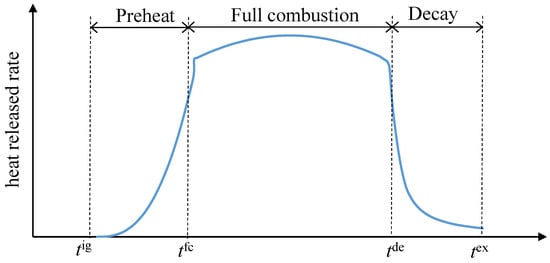
Figure 2.
Illustration of the typical stages of a wildfire.

Table 1.
Model parameters used in this paper.
- Preheat stage. After the ignition time , the heat release rate continuously grows with time t, and its growth rate depends on the combustible vegetation density of the subarea, temperature , humidity , and the wind force :where is a function of temperature and humidity, and is a function of wind force. Currently, we define only on the temperature range from to , which covers the temperature ranges in most of East China and South China. For convenience, we simply define on ten levels of wind force (wind force above level 10 rarely occurs on the mainland), as shown in the function in Table 2.
- Full combustion stage, in which gas combustion is dominant. Whenever the heat release rate reaches a threshold , i.e., , the fire in the subarea enters into the full combustion stage, the time at which is denoted as :The heat release rate during this stage is relatively stable:where is a constant, and is a function of the wind force, the values of which is shown in the third row of the function in Table 2.
- The decay stage, in which charcoal combustion is dominant. Whenever the ratio of the total released heat to the total combustible heat of the vegetation in the subarea reaches a threshold , the fire in the subarea enters into the decay stage, the time at which is denoted as :The heat release rate during this stage decreases with time:where is a constant and is a function of the wind force, the values of which is shown in the fourth row of the function in Table 2. Note that will cause a division-by-zero in Equation (5); at this time, the heat release rate should be calculated according to in Equation (3).Whenever the heat release rate decreases to a lower limit (or the total released heat reaches the total combustible heat), the fire is extinguished, the time at which is denoted as :
As a result, the heat release rate of the fire in subarea at each time t is:
2.2. Loss Estimation
We consider two types of losses: losses of vegetation and losses of other vulnerable assets. Let be the valuation of vegetation and be the valuation of other vulnerable assets in subarea . At each time , we calculate the first type of losses according to the ratio of the total released heat to the total combustible heat of the vegetation:
For other vulnerable assets, we assume that they are partially lost during the preheat stage and completely lost if the fire enters the full combustion stage:
The total loss in at time is
2.3. Fire Propagation
Fire spread in a subarea is unimpeded. On the contrary, the propagation of a fire in a subarea to an adjacent area is considered as probabilistic, and the probability depends on the heat release rate, wind power and direction, and open boundary between the subareas (e.g., for two subareas mainly separated by a river but linked by a narrow shrub zone, of which the narrow shrub zone is considered as the open boundary between the subareas). Let be the length of the open boundary between and and be the angle between the wind direction and the line orthogonal to the open boundary (as shown in Figure 3). We define
where and are two constants between 0 and 1 (taking values of 0.2 and 0.5 in our study, respectively, which results in that , , and ).
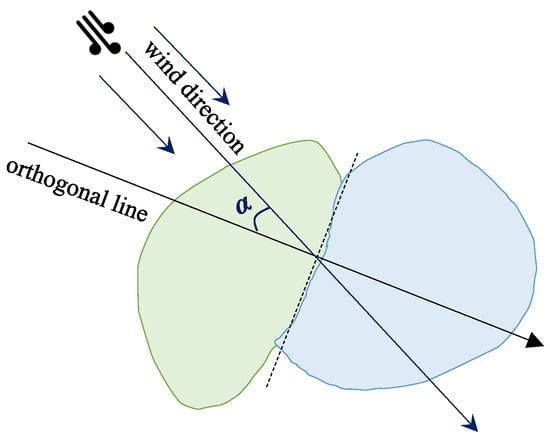
Figure 3.
Angle between the wind direction and the line orthogonal to the open boundary between two subareas.
The probability that the fire propagates from to at the next time is calculated as
where is a threshold of the boundary length, and is a function of the wind force, the values of which is shown in the fifth row of the function in Table 2. As we can see, the value is always one when the wind force level is above six. That is, if the fire is in full combustion (as the heat release rate reaches the threshold ), the open boundary length is not shorter than the threshold , the wind direction is in line with the line orthogonal to the open boundary, and the wind force level reaches or exceeds six, of which the probability is then 1, i.e., the fire propagates from to deterministically.
In the case that there are multiple burning subareas adjacent to a subarea , the joint probability of the ignition in subarea is calculated as
2.4. Simulation Process
Suppose that a set of one or more subareas are burning at the beginning time. From to a given end time , we can simulate the process of fire propagation by iteratively calculating the ignition probabilities and estimating the fire development in related subareas at each time slice t using the following steps:
- Let ; for each subarea , initialize its accumulated ignition probability .
- Set ; if , then exit.
- For each subarea :
- (a)
- Initialize the non-ignition probability .
- (b)
- For each subarea that is adjacent to :
- i
- Calculate according to Equation (12).
- ii
- Update the non-ignition probability as
- (c)
- For each subarea that is adjacent to while having :
- i
- Calculate the probability of the propagation from to aswhere is the expected heat release rate of at time t, which is calculated as
- ii
- Update the non-ignition probability according to Equation (14).
- (d)
- Set .
- (e)
- If (where is a small value, which is set to 0.001 in this study), then add to ;
- (f)
- Otherwise, update the accumulated probability of ignition in asIf , then add to .
- Go to step 2.
For model verification, we used the above process to simulate two wildfires that occurred in Zhejiang Province, China: one in 2020 and the other in 2022. The data came from the Emergency Management Department of Zhejiang Province, recording the time at which each subarea entered into the full combustion stage and the decay stage (as the preheat stages of wildfires were difficult to monitor, the corresponding times were missing). We conducted Monte Carlo simulations, with 50 trials on each wildfire, and compared the simulated full combustion time and decay time with the actual time, then presented the results of the two fires in Figure 4 and Figure 5, respectively. The results showed that the deviations of the simulated time curves from the corresponding actual time curves were generally small. In particular, the full combustion time curves fitted with the actual time curves well. On the two fires, the mean absolute percentage errors (MPAE) of the full combustion time were 7.77% and 6.98%, and the MPAE of the decay time were 8.56% and 7.81%, respectively. As the full combustion stage plays the most important role in fire spread and causes the most losses, the proposed model for wildfire spread and loss estimation is practically useful.
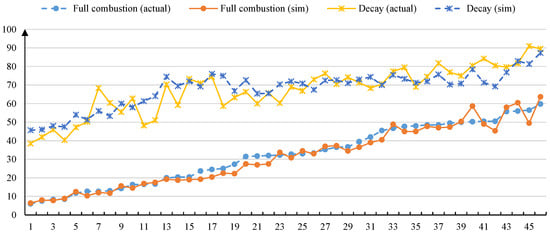
Figure 4.
Comparison of the simulated and actual fire spread in the first wildfire (fire area consisting of 46 subareas).
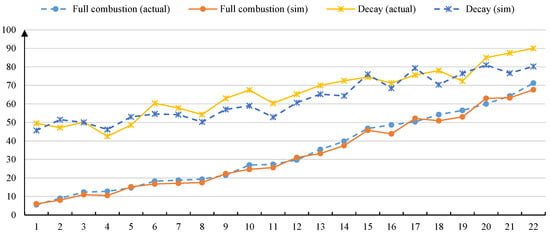
Figure 5.
Comparison of the simulated and actual fire spread in the second wildfire (fire area consisting of 22 subareas).
3. Drone Configuration and Scheduling
3.1. Minimum Number of Firefighting Drones in Preparation for Wildfire
Let be the area (in m2) of subarea . The amount of water for extinguishing the fire in the area is proportional to and at time t. Let W be the amount of water that can be carried by a drone at a time (under the assumption of homogeneous drones, which is not difficult to extend to heterogeneous drones). The least number of firefighting drones required for extinguishing the fire in subarea at time t is
where denotes rounding up to the closest integer, and is a constant. The value of is at most , and the number is at most
A basic principle of firefighting drone preparation for wildfire is that the usage of all drones is sufficient to extinguish the fire in any subarea at any time. Therefore, the minimum number of firefighting drones in preparation for wildfire in the while wild area can be determined as
3.2. Optimization Problem of Firefighting Drone Scheduling
For fire prevention for a wild area , we normally establish a lightweight fire station near a water resource and equip the station with firefighting drones (). Let be the distance from the fire station to subarea , be the speed of a fully-loaded drone from the fire station to subarea , and be the speed of an empty drone (after releasing water) from to the fire station. We also set up at lease one fire sensor in each subarea of : the probability of the sensor perceiving a fire in the subarea is 1 in the full combustion stage and smaller than 1 in the preheat stage. Anyway, whenever we receive the warning from a sensor in subarea at time 0, we pessimistically assume that , i.e., the fire is in the full combustion stage.
Suppose that we receive the warning from a set of one or more subareas at time 0. A firefighting decision is defined as an order (sequence) of subareas in . Let be the time for a drone flying to the shortest subarea in , i.e.,
Whenever there are available drones at time t, we select a candidate set of subareas, each of which has already been ignited (but not yet extinguished) or has an accumulated ignition probability larger than a threshold . We arrange the drones to extinguish the fires in the subareas in in the same order as in .
Based on the above principle, the fitness of a firefighting solution is evaluated using the following steps:
- Let , be the initial number of available drones.
- Calculate according to Equation (21) and select the candidate set of subareas satisfying , which are sorted in the same order as in .
- For each subarea :
- (a)
- Calculate according to Equation (18).
- (b)
- If , then assign drones to subarea , whose fire will be extinguished at time , and these drones will be available at the station at time , and then set .
- (c)
- If , then go to step 4.
- Set .
- Check whether there is any burning subarea whose fire will be extinguished at time t; if so, set the extinguish time to t and heat release rate to zero and remove it from .
- If there is no burning subareas, calculate the total loss and exit.
- Use steps 3 to 5 described in Section 2.4 to update the states of the other subareas at time t; if there is any subarea entering into the full combustion stage, add it to ; if there is any burning subarea whose fire is naturally extinguished at time t, remove it from .
- Check whether there are some drones returning to the station at time t; if so, update the value of .
- Go to step 2.
For each subarea , if it is ignited as a deterministic time and extinguished at time based on the firefighting solution , then its expected loss is calculated according to Equations (8)–(10); otherwise, its expected loss is calculated as
This problem aims to minimize the total loss:
3.3. Optimization Algorithms
The above firefighting drone scheduling problem is to find an optimal sequence of subareas, which is essentially a permutation optimization problem. The solution space has the same structure as the traveling salesman problem (TSP) and permutation flowshop scheduling problem (PFSP), while the fitness evaluation function is significantly more complex and computationally expensive than TSP and PFSP. For a wild area with dozens to hundreds of subareas, the computational cost of exact optimization methods can be unaffordable. Here, we adapt several popular metaheuristic optimization algorithms for TSP/PFSP, which are briefly described as follows:
- GA using order-based solution representation, partial mapping crossover, and swap mutation [42].
- Particle swarm optimization (PSO) using discrete sequence-based particle representation [43], where velocity trail values are used as the probabilities of the components being placed in certain positions of the sequence. We also incorporate a comprehensive learning strategy [44,45] and an adaptive parameter control mechanism [46].
- Differential evolution (DE) adapted for permutation optimization based on floating-to-integer mapping [47], where solutions are encoded as floating vectors and evolved via standard DE mutation and crossover, then decoded to integer sequences based on the order of floating values.
- Biogeography-based optimization (BBO) for permutation optimization based on subsequence migration [48,49]. The migration operator selects a subsequence from the emigrating solution and uses it to replace the corresponding part in the immigrating solution while using the original components in the part to substitute the corresponding components in the other part to avoid duplication.
- Ecogeography-based optimization (EBO) that extends BBO by integrating local and global migration [50,51].
As the fitness evaluation of a solution to the problem involves the computationally expensive simulation process, we mainly focus on WWO [39], which uses a small population to avoid too many fitness evaluations. WWO is a metaheuristic mimicking water wave motions to search the solution space. In WWO, each solution is analogous to a wave with a wavelength , which is inversely proportional to the solution fitness; at each iteration, each solution searches in a range proportional to its wavelength such that high-fitness solutions search in small ranges, while low-fitness solutions search in large ranges (as illustrated in Figure 6), which leads to a good balance between diversity and convergence.
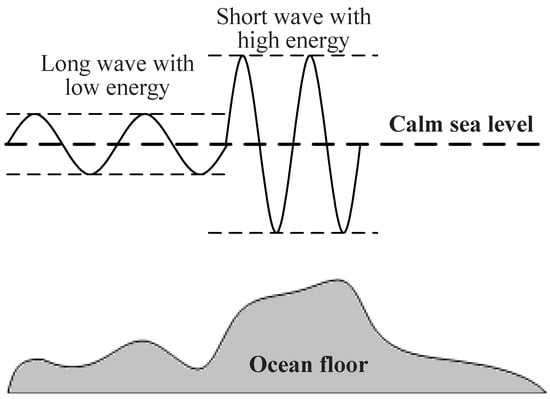
Figure 6.
Illustration of wavelength-based search in WWO.
To adapt the original WWO for continuous optimization to this firefighting drone scheduling problem, we redefine its propagation and breaking operators based on the principles from [52]. Propagation of a solution is performed, for m times, by each, with a probability of , randomly choosing and reversing a subsequence of . In this way, the expected number of subsequence reversals on is , which is inversely proportional to the solution fitness. If the propagated solution is better than the original one, it replaces the original one in the population. After each iteration, the wavelength of each solution is updated as follows (note that the objective function defined in Equation (23) is inversely proportional to its fitness):
where and are the maximum and minimum objective function values in the population, respectively; is a constant taking a value of 1.0026; and is a very small positive value to avoid division by zero.
Whenever the algorithms find a new best-known solution , a breaking operation is performed by generating (a random number in ) neighboring solutions, each being obtained by randomly swapping two subareas and in the sequence. The best neighbor, if better than , will replace in the population. In this way, the algorithm uses diverse solutions to facilitate global search in the early stages while focusing on a small number of solutions to enhance local search in later stages.
We also employ a population reduction policy [53], which reduces the population size from an upper limit to a lower limit :
where and are the upper and lower limit of the population sizes, respectively; is the current generation number; and is the maximum generation number. Whenever the population size should be decreased by 1, the current worst solution is removed.
Algorithm 1 presents the pseudo-code of the WWO algorithm for firefighting drone scheduling, where each solution is evaluated using the procedure described in Section 3.2.
| Algorithm 1: WWO algorithm for firefighting drone scheduling. |
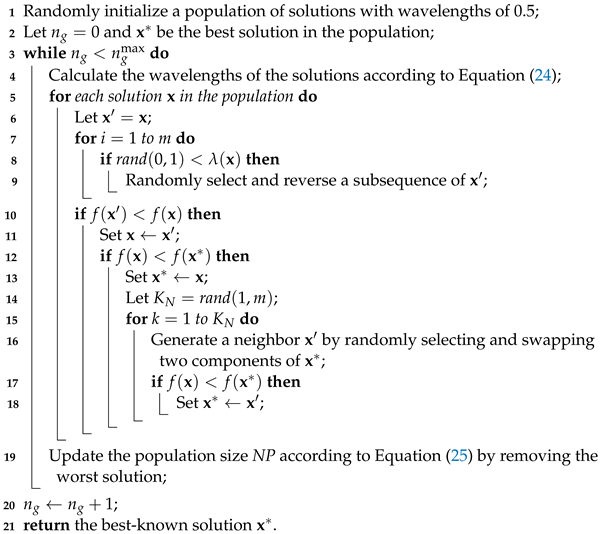 |
The above WWO algorithm uses component swap for local search. To further improve the performance, we propose an enhanced WWO (EWWO) algorithm that includes two additional local search: one using NEH reconstruction [54] and the other using reinsertion, i.e., randomly selecting a component and inserting it into another position. For each breaking operation, EWWO adaptively selects one from the three local search operators based on their past performance. Initially, the three operators have the same selection probability of 1/3. At each generation after the first generations (where is the learning period), the probability of each l-th operator () is updated based on its performance during the previous generations:
where is the number of invocations of the l-th operator, is the number of invocations of the operator that produce better solutions in the recent learning period, and is the computational complexity of the l-th operator (, , and ). Using the adaptive local search, Lines 15–18 of Algorithm 1 are replaced by the procedure shown in Algorithm 2.
| Algorithm 2: WWO breaking using self-adaptive local search. |
 |
3.4. Drone/Staff Configuration and Preplanning
Normally, when configuring drones for a wild area, we fit out water capsules at the fire station such that each drone returning from the fire spot can directly replace the empty capsule with a capsule full of water. Suppose that the (average) time duration for a staff member to fill up a water capsule is ; if N empty water capsules are left by drones at the station at time t and are required to be filled up at time , the least number of staff is
Given a given fire instance, according to the best-known solution obtained by the optimization algorithms, we select a round of drone dispatch that has the maximum and then obtain the required number of staff according to Equation (27).
Moreover, let be the maximum flight time duration of a drone with a fully charged battery and be the total flight time duration of each j-th drone in the solution, where the total number of fully charged batteries required for the operation can be calculated as
Consequently, for a given wild area, we can identify a subset of risky subareas that easily catch fire, as well as record the most common wind force levels and temperature grades. For each risky subarea, we simulate the ignition under each wind force level and temperature grade and use the optimization algorithms to solve the instance. By saving these instances and the corresponding best-known solutions, when encountering a real fire warning from a subarea, we can directly select an existing solution to schedule the drones as well as the required number of staff for firefighting.
Furthermore, we can identify those subareas, where the ignition will cause the most significant losses and/or require the largest number of staff, as the most important subareas and, therefore, to strengthen the management and surveillance of those subareas, we must reduce the risks and consequences as much as possible.
4. Computational Experiments
We test the proposed method in a wild area belonging to the West Mountain Forest Park, Hangzhou, Zhejiang Province, China. The area is divided into 127 subareas, among which eight subareas are identified as high-risk subareas. According to our simulation, when the wind force level is zero (no wind) or one (light air) and the temperature is below 5 °C, most fires ignited from the risky areas can be extinguished by one or two rounds of drone dispatch, i.e, the instances of the firefighting drone scheduling problem are quite easy to solve. Therefore, we select a set of three wind levels of {2, 4, 6} (as the differences between two adjacent wind force levels are relatively small, and wind force levels above eight rarely appear in the area) and a set of three temperature grades of {15–20, 25–30, 35–40} (°C). We also set the number of drones to a random integer in . By simulating the ignition in each high-risk subarea under each wind level and each temperature grade (the wind direction is always assumed to be toward the center of the area), we construct a suite of 72 test instances.
On the test suite, we compare the seven metaheuristic optimization algorithms (GA, PSO, DE, BBO, EBO, WWO, and EWWO). Each algorithm is run for 30 times on each instance, for which we record the minimum and median objective function values (in thousand RMB Yuan or CNY) among the 30 runs and the standard deviation (std). To ensure a fair comparison, for all algorithms, the termination condition is set so that the number of objective function evaluations reaches 50,000. Table 3 presents the results of the seven algorithms on the 72 test instances. We also conduct a non-parametric Wilcoxon rank-sum test to compare the result of EWWO and the result of other algorithms on each instance. Table 4 summarizes the averaged values of the results obtained by each algorithm on the test instances as well as the corresponding ranks among the seven algorithms.

Table 3.
Resulting minimum, median, and standard deviation of the objective function values (i.e., total fire loss in thousand CNY) obtained by the algorithms on the test instances. Symbol indicates that the result is significantly different from the result of EWWO at a confidence level of 95%.

Table 4.
Summary of the experimental results of the seven algorithms on the test instances.
From the results, we can observe that EWWO always obtains the best result on each test instance. Among the other six popular metaheuristic optimization algorithms, GA performs the worst mainly because the genetic selection and crossover operations are elitism-based, making GA to be easily trapped by the local optima. The migration operator of BBO is similar to genetic crossover, and, therefore, the performance of BBO is close to that of GA, although the BBO migration model provide better diversity than genetic selection. Using velocity-based solution movement, the PSO algorithm converges fast, but it also easily falls into premature convergence. Both the DE mutation schema and the EBO global migration model have powerful global exploration abilities and can result in good diversities, and their performances are better than GA, PSO, and BBO. WWO performs the best among the first six algorithms because its wavelength-based control model brings a quite good balance between global exploration and local exploitation. The performance advantage of EWWO over WWO, obviously, is due to the integration and adaptive control of the three local search operators. For the instances with significant losses, using the solutions of EWWO, we can reduce approximately 300,000∼600,000 CNY of losses compared to the solutions of GA and approximately 100,000∼400,000 CNY compared to the solutions of other algorithms. In summary, the experimental results demonstrate that EWWO exhibits a significantly better performance than the other popular algorithms on the test suite. Therefore, we recommend EWWO as the most suitable algorithm to solve the firefighting drone scheduling problem to the fire department.
According to the best-known results obtained by EWWO, among the eight subareas, under the most serious conditions (highest temperature and wind force), the losses in six subareas are approximately 1.1∼1.6 billion CNY, while the losses in the other two subareas are 2.2 and 1.9 billion CNY, respectively. Therefore, the fire department close the major entrances to the top risk subarea enhances the entrance management for the second top risk subarea, significantly reducing the potential fire risks.
Although the seven algorithms use the same number of objective function evaluations, there are still slight differences among their running times. Figure 7 presents the median running time of each of the seven algorithms on instances 1–9 (the time variations are similar on the remaining instances). Moreover, Figure 8 presents the median convergence time of each algorithm on the instances (we consider). As we can observe, with the increase in instance size, the convergence time of EWWO becomes more significantly shorter than that of the other algorithms.
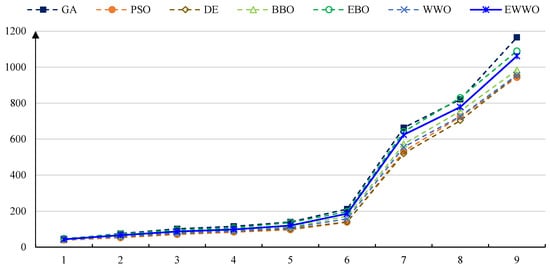
Figure 7.
Median running time of each of the seven algorithms on instances 1–9.
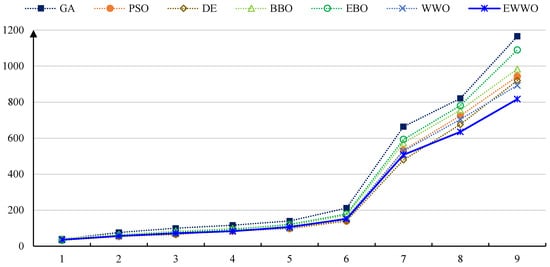
Figure 8.
Median convergence time of each of the seven algorithms on instances 1–9.
5. Conclusions
This paper presents a study consisting of a mathematical model that predicts wildfire spread and the corresponding economic losses that work simultaneously; an optimization problem of firefighting drones scheduling to minimize the fire loss based on the wildfire spread and loss estimation; and a metaheuristic optimization method, in particular, the EWWO algorithm for efficiently solving the optimization problem. The results of the model and algorithms can also help us to configure the drones and staff to support efficient firefighting operations and well as prepare a set of plans in response to possible wildfire occurrences. Validation of the fire spread model on the two real-world wildfires showed that the MPAE of full combustion time and decay time were around 7∼8%, respectively. Experiments of the scheduling algorithms on a set of 72 test instances demonstrated that the solutions obtained by the proposed algorithm of EWWO could reduce approximately 100,000∼600,000 CNY compared to the solutions of other popular algorithms.
The present work has certain limitations. First, we only estimate the losses caused by fire but do not consider the cost of drones in configuration and firefighting. Second, the proposed method limits that the fire in a subarea should be extinguished at a time by a small number of drones, which is not scalable to large areas that need multiple batches of drones for firefighting. Third, the scheduling schema requires that the distance between the fire station (configured with drones) and the utmost subarea cannot exceed the half of the flight range of the drone. Therefore, for large wild areas, we need to set up more fire stations.
In the future work, we will consider the cooperation of drones and ground vehicles [55,56], where ground vehicles carry water and batteries (or support fast battery recharging) for drones to shorten the travel distances of drones and improve the firefighting efficiency. Our ongoing work also considers integrating reinforcement learning into the optimization to improve the problem-solving performance [57].
Author Contributions
Conceptualization, Y.-J.Z.; methodology, R.-Y.W.; software, R.-Y.W.; investigation, X.-C.X.; validation, X.-C.X.; writing—original draft preparation, R.-Y.W.; writing—review and editing, Y.-J.Z.; funding acquisition, Y.-J.Z. All authors have read and agreed to the published version of the manuscript.
Funding
This work was supported by the National Natural Science Foundation of China (grant numbers 61872123, 62372148) and the Natural Science Foundation of Zhejiang Province (grant number LR20F030002).
Informed Consent Statement
Not applicable.
Data Availability Statement
The datasets used in this paper are available at https://www.compintell.cn/en/dataAndCode.html (accessed on 26 December 2023).
Conflicts of Interest
The authors declare no conflicts of interest.
References
- Gabbert, B. A 9-Year USFS Aerial Firefighting Study Left Many Questions Unanswered. Wildfiretoday. 2021. Available online: https://wildfiretoday.com/2021/04/16/a-9-year-usfs-aerial-firefighting-study-left-many-questions-unanswered/ (accessed on 16 December 2023).
- Restas, A. Examining the effectiveness of aerial firefighting with the components of firebreak requirements and footprint geometry—Critics of the present practice. Fire 2023, 6, 351. [Google Scholar] [CrossRef]
- Qin, H.; Cui, J.Q.; Li, J.; Bi, Y.; Lan, M.; Shan, M.; Liu, W.; Wang, K.; Lin, F.; Zhang, Y.F.; et al. Design and implementation of an unmanned aerial vehicle for autonomous firefighting missions. In Proceedings of the IEEE International Conference on Control and Automation, Kathmandu, Nepal, 1–3 June 2016; pp. 62–67. [Google Scholar] [CrossRef]
- Alon, O.; Rabinovich, S.; Fyodorov, C.; Cauchard, J.R. Drones in firefighting: A user-centered design perspective. In Proceedings of the 23rd International Conference on Mobile Human-Computer Interaction, Toulouse, France, 27 September–1 October 2021; ACM: New York, NY, USA, 2021. MobileHCI’21. [Google Scholar] [CrossRef]
- Roldán-Gómez, J.J.; González-Gironda, E.; Barrientos, A. A survey on robotic technologies for forest firefighting: Applying drone swarms to improve firefighters’ efficiency and safety. Appl. Sci. 2021, 11, 363. [Google Scholar] [CrossRef]
- Laszlo, B.; Agoston, R.; Xu, Q. Conceptual approach of measuring the professional and economic effectiveness of drone applications supporting forest fire management. In Proceedings of the 8th International Conference on Fire Science and Fire Protection Engineering, Nanjing, China, 27–29 October 2017; Procedia Engineering. 2018; Volume 211, pp. 8–17. [Google Scholar] [CrossRef]
- Aydin, B.; Selvi, E.; Tao, J.; Starek, M.J. Use of fire-extinguishing balls for a conceptual system of drone-assisted wildfire fighting. Drones 2019, 3, 17. [Google Scholar] [CrossRef]
- Kataeva, L.Y.; Ilicheva, M.N.; Loshchilov, A.A. Mathematical modeling for extinguishing forest fires using water capsules with a thermoactive shell. J. Appl. Mech. Tech. Phy. 2022, 63, 1227–1242. [Google Scholar] [CrossRef]
- Beijing ZhongHangZhi Technology Co., Ltd. TD220 Coaxial Unmanned Helicopter. Available online: https://www.zhz.com/en (accessed on 23 October 2023).
- Viegas, C.; Chehreh, B.; Andrade, J.; Lourenço, J. Tethered UAV with combined multi-rotor and water jet propulsion for forest fire fighting. J. Intell. Robot. Syst. 2021, 104. [Google Scholar] [CrossRef]
- Śmigielski, G.; Dygdała, R.; Zarzycki, H.; Lewandowski, D. Real-time system of delivering water-capsule for firefighting. In Hard and Soft Computing for Artificial Intelligence, Multimedia and Security; Kobayashi, S.Y., Piegat, A., Pejaś, J., El Fray, I., Kacprzyk, J., Eds.; Springer: Cham, Switzerland, 2017; pp. 102–111. [Google Scholar] [CrossRef]
- Zheng, L.; Quan, W. Experimental study of explosive water mist extinguishing fire. In Proceedings of the 5th Conference Performance-based Fire and Fire Protection Engineering, Guangzhou, China, 7–9 December 2010; Procedia Engineering. 2011; Volume 11, pp. 258–267. [Google Scholar] [CrossRef]
- Śmigielski, G.; Toczek, W.; Dygdała, R.; Stefański, K. Metrological analysis of precision of the system of delivering a water capsule for explosive production of water aerosol. Metrol. Measure. Syst. 2016, 23, 47–58. [Google Scholar] [CrossRef][Green Version]
- Czerniak, J.; Śmigielski, G.; Ewald, D.; Paprzycki, M.; Dobrosielski, W. New proposed implementation of ABC method to optimization of water capsule flight. In Proceedings of the Federated Conference on Computer Science and Information Systems, Lodz, Poland, 13–16 September 2015; pp. 489–493. [Google Scholar] [CrossRef]
- Czerniak, J.M.; Ewald, D.; Śmigielski, G.; Dobrosielski, W.T.; Apiecionek, Ł. Optimization of fuel consumption in firefighting water capsule flights of a helicopter. In Recent Advances in Computational Optimization: Results of the Workshop on Computational Optimization; Fidanova, S., Ed.; Springer: Cham, Switzerland, 2016; pp. 39–49. [Google Scholar] [CrossRef]
- Wang, X.; Liu, H.; Tian, Y.; Chen, Z.; Cai, Z. A fast optimization method of water-dropping scheme for fixed-wing firefighting aircraft. IEEE Access 2021, 9, 120815–120832. [Google Scholar] [CrossRef]
- Zheng, Y.J.; Du, Y.C.; Sheng, W.G.; Ling, H.F. Collaborative human-UAV search and rescue for missing tourists in nature reserves. INFORMS J. Appl. Analy. 2019, 49, 371–383. [Google Scholar] [CrossRef]
- Du, Y.; Zhang, M.; Ling, H.; Zheng, Y. Evolutionary planning of multi-UAV search for missing tourists. IEEE Access 2019, 7, 73480–73492. [Google Scholar] [CrossRef]
- Kiani, F.; Seyyedabbasi, A.; Aliyev, R.; Gulle, M.U.; Basyildiz, H.; Shah, M.A. Adapted-RRT: Novel hybrid method to solve three-dimensional path planning problem using sampling and metaheuristic-based algorithms. Neural Comput. Appl. 2021, 33, 15569–15599. [Google Scholar] [CrossRef]
- Kiani, F.; Seyyedabbasi, A.; Nematzadeh, S.; Candan, F.; Çevik, T.; Anka, F.A.; Randazzo, G.; Lanza, S.; Muzirafuti, A. Adaptive metaheuristic-based methods for autonomous robot path planning: Sustainable agricultural applications. Appl. Sci. 2022, 12, 943. [Google Scholar] [CrossRef]
- Zheng, Y.J.; Chen, S.Y.; Ling, H.F. Evolutionary optimization for disaster relief operations: A survey. Appl. Soft Comput. 2015, 27, 553–566. [Google Scholar] [CrossRef]
- Luo, Z.; Zhang, Y.; Mu, L.; Huang, J.; Xin, J.; Liu, H.; Jiao, S.; Xie, G.; Yi, Y. A UAV path planning algorithm based on an improved D* Lite algorithm for forest firefighting. In Proceedings of the Chinese Automation Congress, Shanghai, China, 6–8 November 2020; pp. 4233–4237. [Google Scholar] [CrossRef]
- Harikumar, K.; Senthilnath, J.; Sundaram, S. Multi-UAV oxyrrhis marina-inspired search and dynamic formation control for forest firefighting. IEEE Trans. Autom. Sci. Eng. 2019, 16, 863–873. [Google Scholar] [CrossRef]
- Hong, L.; Wang, Y.; Du, Y.; Chen, X.; Zheng, Y. UAV search-and-rescue planning using an adaptive memetic algorithm. Front. Inf. Technol. Electron. Eng. 2021, 22, 1477–1491. [Google Scholar] [CrossRef]
- Zheng, Y.; Du, Y.; Ling, H.; Sheng, W.; Chen, S. Evolutionary collaborative human-UAV search for escaped criminals. IEEE Trans. Evol. Comput. 2020, 24, 217–231. [Google Scholar] [CrossRef]
- Zheng, Y.J.; Du, Y.C.; Su, Z.L.; Ling, H.F.; Zhang, M.X.; Chen, S.Y. Evolutionary human-UAV cooperation for transmission network restoration. IEEE Trans. Ind. Informat. 2021, 17, 1648–1657. [Google Scholar] [CrossRef]
- Wang, C.; Liu, P.; Zhang, T.; Sun, J. The adaptive vortex search algorithm of optimal path planning for forest fire rescue UAV. In Proceedings of the IEEE 3rd Advanced Information Technology, Electronic and Automation Control Conference, Chongqing China, 12–14 October 2018; pp. 400–403. [Google Scholar] [CrossRef]
- Xiang, A.; Wang, L. Research on path planning of UAV forest fire fighting based on improved ant colony algorithm. In Proceedings of the 2021 7th International Conference on Computing and Artificial Intelligence, Tianjin, China, 23–26 April 2021; ACM: New York, NY, USA, 2021; pp. 289–295. [Google Scholar] [CrossRef]
- Xu, Y.; Li, J.; Zhang, F. A UAV-based forest fire patrol path planning strategy. Forests 2022, 13, 1952. [Google Scholar] [CrossRef]
- Alsammak, I.L.H.; Mahmoud, M.A.; Gunasekaran, S.S.; Ahmed, A.N.; AlKilabi, M. Nature-inspired drone swarming for wildfires suppression considering distributed fire spots and energy consumption. IEEE Access 2023, 11, 50962–50983. [Google Scholar] [CrossRef]
- Xavier Viegas, D. Forest fire propagation. Philos. Trans. Royal Soc. London. Series A 1998, 356, 2907–2928. [Google Scholar] [CrossRef]
- Li, J.; Li, X.; Chen, C.; Zheng, H.; Liu, N. Three-dimensional dynamic simulation system for forest surface fire spreading prediction. Int. J. Pattern Recogn. Artif. Intell. 2018, 32, 1850026. [Google Scholar] [CrossRef]
- Alexandridis, A.; Vakalis, D.; Siettos, C.; Bafas, G. A cellular automata model for forest fire spread prediction: The case of the wildfire that swept through Spetses Island in 1990. Appl. Math. Comput. 2008, 204, 191–201. [Google Scholar] [CrossRef]
- Rui, X.; Hui, S.; Yu, X.; Zhang, G.; Wu, B. Forest fire spread simulation algorithm based on cellular automata. Nat. Hazards 2018, 91, 309–319. [Google Scholar] [CrossRef]
- Mutthulakshmi, K.; Wee, M.R.E.; Wong, Y.C.K.; Lai, J.W.; Koh, J.M.; Acharya, U.R.; Cheong, K.H. Simulating forest fire spread and fire-fighting using cellular automata. Chin. J. Physics 2020, 65, 642–650. [Google Scholar] [CrossRef]
- Wu, Z.; Wang, B.; Li, M.; Tian, Y.; Quan, Y.; Liu, J. Simulation of forest fire spread based on artificial intelligence. Ecol. Ind. 2022, 136, 108653. [Google Scholar] [CrossRef]
- Cheng, H.; Hadjisophocleous, G.V. The modeling of fire spread in buildings by Bayesian network. Fire Saf. J. 2009, 44, 901–908. [Google Scholar] [CrossRef]
- Shaham, Y.; Benenson, I. Modeling fire spread in cities with non-flammable construction. Int. J. Disaster Risk Reduct. 2018, 31, 1337–1353. [Google Scholar] [CrossRef]
- Zheng, Y.J. Water wave optimization: A new nature-inspired metaheuristic. Comput. Oper. Res. 2015, 55, 1–11. [Google Scholar] [CrossRef]
- Weber, R.O. Toward a comprehensive wildfire spread model. Int. J. Wildland Fire 1991, 1, 245–248. [Google Scholar] [CrossRef]
- Cheng, H.; Hadjisophocleous, G.V. Dynamic modeling of fire spread in building. Fire Saf. J. 2011, 46, 211–224. [Google Scholar] [CrossRef]
- Wang, L.; Zhang, L.; Zheng, D.Z. A class of order-based genetic algorithm for flow shop scheduling. Int. J. Adv. Manuf. Technol. 2003, 22, 828–835. [Google Scholar] [CrossRef]
- Liao, C.J.; Tseng, C.T.; Luarn, P. A discrete version of particle swarm optimization for flowshop scheduling problems. Comput. Oper. Res. 2007, 34, 3099–3111. [Google Scholar] [CrossRef]
- Liang, J.J.; Qin, A.K.; Suganthan, P.; Baskar, S. Comprehensive learning particle swarm optimizer for global optimization of multimodal functions. IEEE Trans. Evol. Comput. 2006, 10, 281–295. [Google Scholar] [CrossRef]
- Zheng, Y.; Ling, H.; Xue, J.; Chen, S. Population classification in fire evacuation: A multiobjective particle swarm optimization approach. IEEE Trans. Evol. Comput. 2014, 18, 70–81. [Google Scholar] [CrossRef]
- Zheng, Y.J.; Ling, H.F.; Guan, Q. Adaptive Parameters for a Modified Comprehensive Learning Particle Swarm Optimizer. Math. Prob. Eng. 2012, 2012, 207318. [Google Scholar] [CrossRef]
- Chakraborty, U.K.; Turvey, K.P. Floating-point to integer mapping schemes in differential evolution for permutation flow shop scheduling. Int. J. Bio-Inspired Comput. 2010, 2, 183–204. [Google Scholar] [CrossRef]
- Zheng, Y.; Lu, X.; Zhang, M.; Chen, S. Biogeography-Based Optimization: Algorithms and Applications; Springer: Berlin/Heidelberg, Germany, 2018. [Google Scholar] [CrossRef]
- Zheng, Y.; Ling, H.; Xue, J. Disaster rescue task scheduling: An evolutionary multiobjective optimization approach. IEEE Trans. Emerg. Top. Comput. 2018, 6, 288–300. [Google Scholar] [CrossRef]
- Zheng, Y.J.; Ling, H.F.; Xue, J.Y. Ecogeography-based optimization: Enhancing biogeography-based optimization with ecogeographic barriers and differentiations. Comput. Oper. Res. 2014, 50, 115–127. [Google Scholar] [CrossRef]
- Du, Y.C.; Zhang, M.X.; Cai, C.Y.; Zheng, Y.J. Enhanced biogeography-based optimization for flow-shop scheduling. In Bio-Inspired Computing: Theories and Applications; Qiao, J., Zhao, X., Pan, L., Zuo, X., Zhang, X., Zhang, Q., Huang, S., Eds.; Springer: Singapore, 2018; pp. 295–306. [Google Scholar]
- Zheng, Y.J.; Lu, X.Q.; Du, Y.C.; Xue, Y.; Sheng, W.G. Water wave optimization for combinatorial optimization: Design strategies and applications. Appl. Soft Comput. 2019, 83, 105611. [Google Scholar] [CrossRef]
- Zheng, Y.J.; Zhang, B. A simplified water wave optimization algorithm. In Proceedings of the IEEE Congress on Evolutionary Computation, Sendai, Japan, 25–28 May 2015; pp. 807–813. [Google Scholar] [CrossRef]
- Nawaz, M.; Enscore, E.E.; Ham, I. A heuristic algorithm for the m-machine, n-job flow-shop sequencing problem. Omega 1983, 11, 91–95. [Google Scholar] [CrossRef]
- Weng, Y.Y.; Wu, R.Y.; Zheng, Y.J. Cooperative truck-drone delivery path optimization under urban traffic restriction. Drones 2023, 7, 59. [Google Scholar] [CrossRef]
- Wu, G.; Mao, N.; Luo, Q.; Xu, B.; Shi, J.; Suganthan, P.N. Collaborative truck-drone routing for contactless parcel delivery during the epidemic. IEEE Trans. Intell. Transp. Syst. 2022, 23, 25077–25091. [Google Scholar] [CrossRef]
- Siddiqui, A.B.; Aqeel, I.; Alkhayyat, A.; Javed, U.; Kaleem, Z. Prioritized user association for sum-rate maximization in UAV-assisted emergency communication: A reinforcement learning approach. Drones 2022, 6, 45. [Google Scholar] [CrossRef]
Disclaimer/Publisher’s Note: The statements, opinions and data contained in all publications are solely those of the individual author(s) and contributor(s) and not of MDPI and/or the editor(s). MDPI and/or the editor(s) disclaim responsibility for any injury to people or property resulting from any ideas, methods, instructions or products referred to in the content. |
© 2024 by the authors. Licensee MDPI, Basel, Switzerland. This article is an open access article distributed under the terms and conditions of the Creative Commons Attribution (CC BY) license (https://creativecommons.org/licenses/by/4.0/).